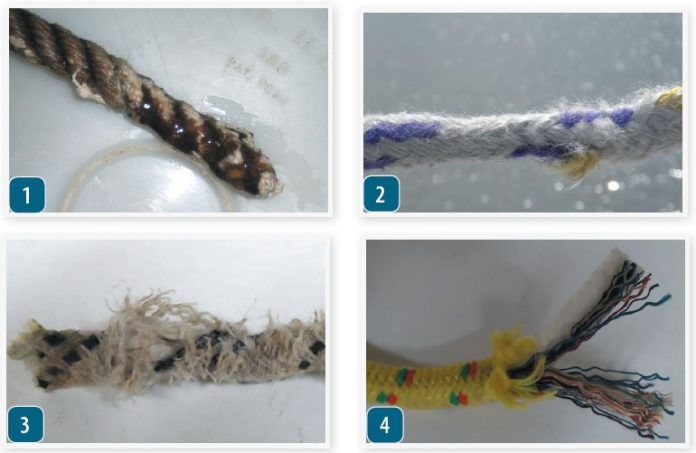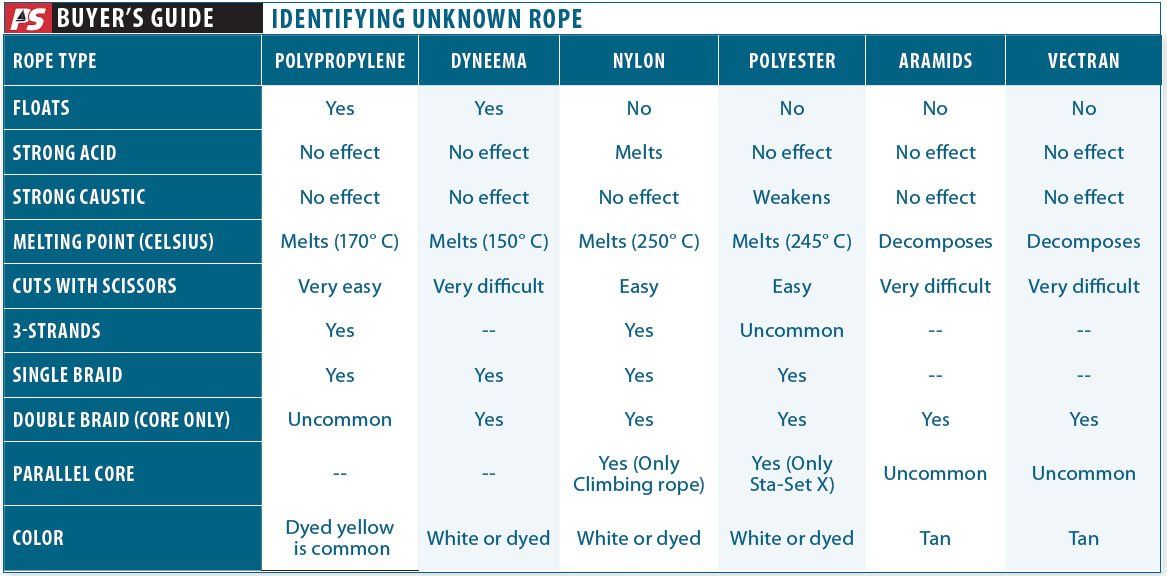
When buying rope from a store you verify its source with a glance at the spool and learn its composition, elasticity, and other characteristics by checking the manufacturers catalog. Pull it out of the remnant bin, might-need pile, the recycle bin, or even off eBay, and this certainty evaporates.
Using the wrong rope for the job is a recipe for failure. Fortunately, with a trained eye and a little knowledge of physical properties, making a rough identification is simple enough.
Construction details provide our first clues. Three-strand rope is most commonly nylon but may be polyester. The acid test, below, will easily discriminate. Single-braid is usually nylon, polyester, or polypropylene, or Dyneema. Aramids (Kevlar, Nomex, Techron, and Twaron) and Vectran (similar to aramids, but technically different) have poor UV resistance and are usually found in the core of a double-braid rope, although racers sometimes strip covers to save a few ounces aloft, at the cost of reduced life expectancy.
Polypropylene does not resist UV well either, but single braids made from it are common, cheap, and considered disposable after a single season in the sun. Double-braid with a parallel core can be nylon (climbing rope) or polyester (Sta-Set X has a parallel core with a scrim wrapping). Aramids and Dyneema are generally not woven this way.

Cover Patterns. Although not definitive, some of the braid patterns are quite distinctive, suggesting what it might be and often ruling out what it cannot be. For example, a rope with a distinctive X pattern of flecks and a parallel core wrapped in a fiber scrim is almost certainly Stay-set X. But a solid color single- or double-braid could be almost anything.
Covers. High modulus cores are often covered with polyester to increase diameter for handling, to increase friction, protect against chafe, and for economy. Other combinations are also possible. Thus, in the case of double-braid ropes, the cover and core must be tested separately.
Texture. Dyneema, for example, is very slippery, unable to hold any but specialized knots. However, we hesitate to list slipperiness as an identifying characteristic, because all synthetics can seem slippery when new, and unless youre familiar with Dyneema, the difference isn’t always obvious. Polypropylene covers are slippery and light when new, but rapidly become stickier with exposure to the sun.
Color. All lines can be dyed, so this is an unreliable indicator. But cores often are not dyed. Most fibers are vaguely white when undyed, though aramids and Vectran have a characteristic golden color.
The Tests
Density. Place a length of rope in seawater, making certain to massage all of the air bubbles out. A touch of soap can help. Polyethylene (Dyneema) and polypropylene ropes float, all others sink. If you use less dense freshwater for this test, the Dyneema will just barely float.
Acid. Place a few drops of battery acid on the rope; nylon will darken and melt in 5-10 minutes, all others will be unaffected. Weak acids, such as vinegar, will weaken nylon, but the effects may not be visible. Exercise caution when working with battery acid or caustics (lye).
Caustic. Strong sodium hydroxide (lye) will degrade polyester. Instead of melting, the fibers simply become very weak, breaking when the rope is flexed or twisted hard, though it takes a little longer. Other fibers are unaffected.
Cutting with scissors. Related to strength, this quickly separates conventional ropes (nylon, polyester, and polypropylene) from high modulus types (Dyneema, aramid, or Vectran). Using ordinary paper scissors, cut a known sample of nylon. Then cut a piece of the unknown. The difference in difficulty will be obvious with high modulus ropes; they are very hard to cut and tend to just fuzz if the scissors are not very sharp.
Melting. Nylon, polyester, polypropylene, and Dyneema melt easily with a lighter. Appearances and speed vary, making it difficult to be certain which is which. However, aramids and Vectran just char. The only way to fuse rope ends is to cut the core back a little and then melt and mold the polyester cover over the core (a conventional whipping holds it together).

Estimating Strength
For sheets, non-critical control lines, or to just to steady your nerves, the preceding tests and observations were probably enough.
The rope may also be old, and the effects of UV and fatigue unknown. For a halyard, lifeline or any critical application, more definitive testing is in order.
If the line is double braid, normally, the cover is the same strength as the core (this is actually a requirement for standard double-braid splices to work properly). Count the cover strands.
For example, if the line has a breaking strength of 8000 pounds and a 24-strand cover, each strand should hold about 8000/(24 x 2) = 167 pounds.
If you make a loop using one strand, tied with a fishermans knot or similar, it should have a breaking strength of about 167 x 2 x 65 percent knot efficiency = 217 pounds. You should be able to step on the loop you made without breaking.
There are many variations, depending on rope construction. If the rope is UV damaged the core will be better than the cover, but it will have suffered from internal abrasion and fatigue. In our tests, the core and cover are weakened equally by every aging process, except external chafe.
The bottom line is that by testing one or a few strands, you should be able to use body weight to estimate the total strength of the rope.

































